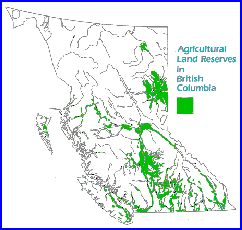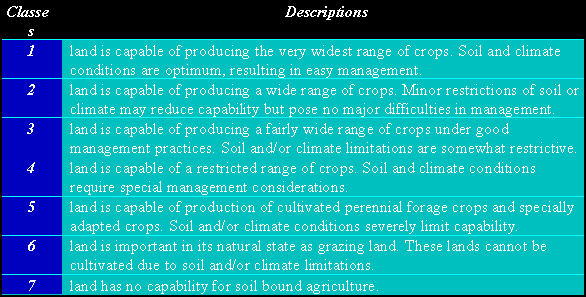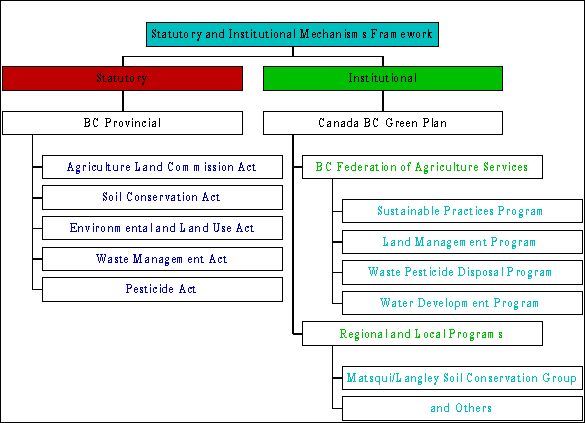 | ||||||
| Articles | Projects | Resume | Cartoons | Windsurfing | Paintings | Album |
Soil Conservation in BC

by Waterose et al.
Judith Burke, and
I. Anderton, S. Elliott, M. Melatdoost, H. Wijoyo
Introduction:
Agricultural practices in British Columbia only represent a minute part in land and resource use, but its contribution toward food supply in the province is about 70%. As a consequence, intensive agricultural practices must be employed to meet food demand. Under the Green Plan, the BC and Federal governments try to promote sustainable agricultural practices by adjusting existing practices to meet compliance. Such attempts are based on the understanding of all possible impacts associated with agricultural practices. The following discusses the types of impacts on soil quality and government frameworks to meet sustainable practices.Soil Science:
Soil is one of the most important resources that may be considered to be renewable. However, only about 5 percent of BC land is allocated as an Agricultural Land Reserve as illustrated in Figure 1 below.

The limited amount of available agricultural land is primarily due to the BC’s extreme topography. As well, competition with other users, such as housing, industry, transportation, recreation, and wildlife habitat has further reduced areas that would otherwise be available for agriculture. In this limited area, farmers try to meet the food demands of BC residents. Therefore, soil conservation is crucial to ensure an adequate food supply for the future. Since 1973 the Agricultural Land Commission (ALC) has been the primary steward of BC's agricultural land. The goals of the ALC are to preserve British Columbia's agricultural lands for present and future use, and, to encourage the establishment and maintenance of BC's farms and farming community. To accomplish this objective, the ALC developed the Land Capability Classification System for Agriculture in BC as illustrated below in Table 1 and Table 2. This system and the Canada Land Inventory Mapping System provide an agricultural classification of soils. It is based on considerations of climatic, soil and landscape limitations with regard to the agricultural use and productivity for common field crops.
Table 1. Land Capability Classification for Agriculture in BC.

Table 2. Land Capability Sub-Classification for Agriculture in BC.

Soil productivity is measured based on the moisture content, grain sizes, organic content, and soil structure. The limitations for agricultural use, or the special management practices required for soil improvement, are categorized in nine subclasses. These subclasses include degree of water content deficiency, salinity, soil structure, stoniness and topography. Other external forces that affect the status of soil such as erosion, extreme weather, inundation and other minor characteristics are included in the classification. The rating system denotes that lands listed with an improved rating are in their native condition and do not require upgrading. An unimproved rating indicates that special agricultural management is necessary to render these areas productive.
This system does not indicate the yield of individual crops. As indicated in Table 1, Class 3 can produce a wide variety of crops; however, Class 4 may produce higher yields of a more limited variety of crops. A higher-numbered class does not necessarily mean lower quality agricultural land. For example Class 5 land is suitable for specially adapted crops. Similar characteristics are mapped on a much smaller scale at the federal level.
In addition to the soil classification system, the federal government maintains the Canada Land Inventory Mapping system. This inventory is based on the organic content of the soil as well as external factors that influence soil fertility. This system is a broad classification which excludes many small pockets of agricultural activities. These areas are considered unproductive on this scale. This is further exacerbated by variations in altitude, topography, soil characteristics, and climate. This factor of scale is the key difference between the provincial soil classification system and the Canada Land Inventory Mapping system.
Statutory and Institutional Mechanisms Framework:
The federal government of Canada is committed to preserving agricultural land in Canada, hence the Federal-Provincial Committee on land use. This committee examines integrated land and resource planning (Agenda 21-Chapter 10: Internet). In addition to Federal-Provincial initiatives such as the Green Plan there are provincial legislative and institutional mechanisms for the protection of agricultural lands and the conservation of soil. One of the key institutions in British Columbia is the BC Federation of Agriculture Services for farmers. Two key statutes in British Columbia include the Soil Conservation Act and the Agricultural Land Commission Act. These mechanisms are illustrated in Figure 2 below.

The Agricultural Land Commission Act provides the legislative authority for the establishment of a commission of not less than five members to be appointed by the Lieutenant Governor in Council that primarily establishes the regulations pertaining to the administration of agricultural Crown land and agricultural land reserves. The primary objective of the commission is to preserve agricultural land and to encourage the establishment and maintenance of farming in British Columbia. In addition, the commission has the power to designate Crown land for agricultural use and to acquire by purchase new land which may be designated as agricultural land reserve. There are specific provisions in the act and the regulations to request to use agricultural reserve land for other than farm use such as for use as an unpaved airstrip, a sanitary land fill, or a gravel pit. In addition the base plan regulations provide the statutory framework for land planning at the municipal and regional levels.
The second key statutory instrument in British Columbia is the Soil Conservation Act which provides the framework for the movement of soil by a permit process that is administered by the commission described above. A person is prohibited from removing soil from an agricultural land reserve area without a permit except under certain conditions such as for the purposes of clearing, preparing or cultivating land under good agricultural practises. In addition, a person is prohibited from adding landfill to an area in an agricultural land reserve without a permit and payment of the prescribed fees.
There are other statutory mechanisms that impact the management of agricultural land and soils including the Environmental and Land Use Act, the Waste Management Act and the Pesticide Act.
In addition to these statutory mechanisms there are institutional mechanisms that provide a multi-stakeholder consultation framework and forum for the preservation and conservation of agricultural soils in Canada and British Columbia. The Canada-British Columbia Green Plan for agriculture provides funding and subsidies to enable farmers to adopt sustainable practices in compliance with evolving regulations (BCFA Green Plan, Internet). The B.C Federation of Agriculture Services for farmers established the Sustainable Practices Program (SPP) that provides the framework to implement innovative programs to conserve and preserve soil and prevent wind and water erosion. Some of these programs include the land management program, the waste pesticide disposal program, and the water development program. These and smaller programs, that may be organised by sector type or regions, are common in BC. For example, the Matsqui/Langley Soil Conservation Group is one of several groups that operate to educate the public, develop soil conservation practices, and provide innovative soil stewardship plans (Matsqui, Internet).
Soil Conservation:
The increased awareness of the impacts of chemical and physical disturbances to agricultural soil and soil loss have resulted in the development and implementation of federal and provincial legislation and programs to protect agricultural land and to conserve soil.The chemical disturbances of soil may be minimised by regulating the amounts and types of fertilisers and pesticides used on agricultural reserve land. These items are regulated primarily by the Agricultural Reserve Land Act and the Pesticide Act. In addition, the placement and movement of contaminated soils into an area that is designated as agricultural reserve land is prohibited under the Waste Management Act and the Soil Conservation Act. Farming practices such as irrigation that affect the salinity of the soil are carefully monitored by the BC Federation of Agriculture Services for farmers.
The physical disturbances of soil may be minimised by reducing the magnitude and frequency of any activities that may result in soil compaction and soil mixing. Soil mixing activities on agricultural reserve land are regulated by the Agricultural Land Commission Act and must be approved by the agricultural commission before any such activities may be undertaken. Moreover, guidelines provided by the BC Federation of Agriculture Services are more likely to have an influence on reducing activities that cause soil compaction; for example, the operation of heavy farm equipment.
Soil loss due to erosion may be minimised by reducing the severity of water and wind erosion by using physical barriers or rotating crops. Solutions may be implemented by using sustainable farming practices such as those introduced in the provincial Land Management Program or the Sustainable Practices Program. In addition, in some cases, soils or organic matter may have be added to an agricultural area; this process is regulated by permit under the Soil Conservation Act.
Discussion:
The Federal and Provincial initiatives are coordinated through the Federal-Provincial Committee on integrated land use planning and the Canada Land Inventory Mapping projects. This Canada Land Inventory Mapping classifies soil productivity only in the broadest sense. Another example of a joint initiative is the Green plan which is aimed at improving agricultural practices and conserving soil. In addition to federal mechanisms, provincial initiatives effectively manage agricultural issues of more localized nature.The primary provincial legislative tools include the Soil Conservation Act (SCA) and the Agricultural Land Commission Act (ALCA). The primary objective of the ALCA is to preserve agricultural land. Consequently, it is the authority of the Agricultural Land Reserves and the Agricultural Land Commission. This commission developed the Land Capability Classification System previously described. The primary level of classification is concerned with good management practices. The secondary level of classification is concerned with the physical and chemical characteristics of the soil. The rating of the soils (improved versus unimproved conditions) provides some protection from being further depleted beyond their present capacity to produce.
Ideally, these classification sections could provide additional detail regarding quantitative limits on the amounts of chemical fertilizers, such as nitrogen, that can be applied. In addition, there could be a classification section that deals with effluent irrigation. The classification system is an important element of productivity. Another limitation is that yield ratios are excluded from the classifications. Neither the science classification nor the legislative instruments discussed previously differentiate areas of yield or productivity. Consequently, the rating is limited. In addition, there is no limit on the amount of time that an area of productive agricultural soil is kept in active production.
The conservation of agricultural soil is the main goal of the SCA. This act is also concerned with the preparation or cultivation of land utilizing sound agricultural practices. In addition, any movement of soil within Agricultural Land Reserves is regulated by the SCA. The two acts and the classification systems are linked.
The development of good agricultural practices can enhance productivity while at the same time conserving agricultural soil. Such practices are promoted by local programs such as those provided by the Matsqui/Langley Soil Conservation Group. This group is sponsored by the BC Federation of Agriculture Services for farmers, which established the SPP. The government of BC tries to promote environmentally sustainable agricultural practise s by using policy instruments coupled with institutional mechanisms. The policies, legislated by various acts, give statutory power to the BC government to take essential precautions to protect and restore agricultural land and soils. The provincial initiatives are backed by federal-provincial initiatives such as the Canada-BC Green Plan.
References:
Agenda 21, Chapter 14. Internet Reference. Available at URL: http://iisd1.iisd.ca/worldsd/canada/prject/c14.htm
BCFA (British Columbia Federation of Agriculture) Green Plan. Internet Reference. Available at URL: http://www.bcfa.bc.ca/bcfa/ardcorp_programs.html
BC SOILS INFORMATION. Internet Reference. Available at URL: http://www.agf.gov.bc.ca/agric/resplan/bcsoils/datdirct.htm
Land Capability for Agriculture Canada. Internet Reference. Available at URL: http://neonet.nlr.nl/providers/neonet.nlr.nl/local/ceos/datasets/CANEMRCCRSLCA.html
Matsqui/Langley Soil Conservation Group. Internet Reference. Available at URL: http://www.island.ent/~awpb/aware/id53.html

 email Waterose
email Waterose
Please Sign My Guestbook
Please View My Guestbook

| Articles | Projects | Resume | Cartoons | Windsurfing | Paintings | Album |
 | ||||||